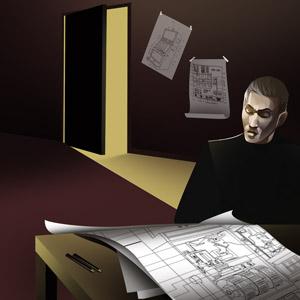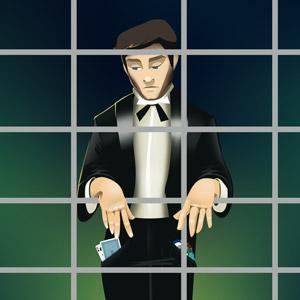Many people devote their lives to the pursuit of happiness, some of whom believe that it’s material wealth that will bring them this coveted happiness. For certain people, this means a lifetime of dedication and hard work. For others, it comes in the form of scratch lottery tickets or entering contests. But fewer still have devoted their lives to a very specific calling. They are slot cheats.
These individuals dream of getting rich with a very specific method: by visiting casinos and attempting to beat the house edge, particularly when it comes to playing slot machines. It’s only a select few that succeed. The odds are against them, especially with changing technology and top-notch security measures, and most are inevitably caught. Regardless, there are two men who have left a mark on the world of casino cheats; two names that remain legends today: Tommy Glenn Carmichael and Dennis Nikrasch.
So… which genius slot machine cheat ultimately wears the crown? We’ll let you decide.
Tommy Glenn Carmichael: the infamous inventor
The early years
Tommy Glenn Carmichael was born on July 5, 1950 in Tulsa, Oklahoma. He was a smart kid, always trying to figure out how things worked. At that point in history technology was developing quickly, and it was something that appealed to him from an early age. Carmichael wanted to understand things, to be able to take something apart and see what it was and tinker with it. This early interest led him to open up a repair shop for TVs and other electronics, but competing businesses sprang up shortly after, and his success didn’t last.
Fast forward to one day in 1980, a high school friend stopped by for a visit, and he’d brought Carmichael a surprise in the trunk of his car: a slot machine along with a top-bottom joint. The slot machine was right up Carmichael’s alley – interesting new technology that could be taken apart and studied. And the top-bottom joint? It was a tool, one that could be used to accomplish something specific.
Tools of a slots cheat
The top-bottom joint was the slot cheat’s best friend, a gadget that could be used to win at slots. It consisted of two parts that worked together to “fool” the hopper, the mechanism that releases the payout from a winning combination.
The bottom was a short piece of guitar string, and the top was a metal piece in the shape of the number nine. First, the bottom piece was inserted into the bottom left corner of the machine. This diverted electricity from the circuit board and redirected it throughout the machine. The top piece was then inserted into the coin slot. This would complete the electrical circuit by hot wiring the hopper’s motor. The result activated a payout.
The set-up was astoundingly straightforward: simply recreate the kind of circuit that resulted in a true winning combination, and you’d get the payout without having to waste money waiting for a random winning spin. It was so effortless that it was almost comical.
The lure of Vegas
It didn’t take long for Carmichael to take the machine apart and develop a deep understanding of how it, and the top-bottom joint, functioned. After that, it didn’t take much convincing to get him to see how far his little hobby would take him – none, in fact. With a doomed business, community service for two drug possession convictions, and a third failed marriage, Carmichael really didn’t have much to lose.
So off he went – headed to Vegas with his trusty top-bottom joint and traveled from casino to casino, winning thousands as he went. Luckily for Carmichael, this began in 1980. Technology was developing, but in such a way that he could more than keep up with it. And, it would be several years before casinos began implementing security measures and installing cameras, so Carmichael could just stroll in and take advantage of casinos as he pleased.
Carmichael was living the dream, but as time passed, casinos and police gradually caught on to this trend of cheating tools. After five years of breezing his way through big wins, the police caught him in the act with the incriminating top-bottom joint in his pocket. Of course, he tried to talk his way out of it, claiming that it was a tool he used for his car. The police weren’t buying it. The result? A sentence of five years in prison.
Finding his calling
Five years of slot machine cheating; five years in prison. It was a significant amount of time for Carmichael to seriously consider the life choices he had made and to confront the decisions he had ahead of him. Most people would see the common sense in making plans to turn your life around. The risk of getting caught just isn’t worth it.
But for Carmichael, that’s not what prison taught him. Of course he realized the value in quitting, he wasn’t stupid. No, he saw another alternative, a superior one, in his mind: just get better at what you’re doing. If you can smarten up and improve, you can avoid the same mistakes that landed you in trouble.
And that’s exactly what he did.
Friends in low places
In prison, he met a guy named Michael Balsamo, and they made plans to get together once they were both released. They would create a team, a more sophisticated system to cheat casinos, a way to continue down the same path – but without getting caught.
Eventually both men got out of prison. They met up, and they both came to the realization that the past five years had done a lot of favors for the electronic gaming industry. There was new technology like microprocessors and stricter casino security protocols. The top-bottom joint was outdated and virtually useless. But Carmichael was unfazed by these changes. In fact, they provided him with a welcome challenge that would get his creativity flowing.
After buying and studying a new machine, Carmichael developed another device, the Monkey Paw. When placed up the payout chute, the device triggered a micro switch in the machine, and machines would release a payout – up to $1,000 an hour. That’s when Carmichael knew that he was invincible, unbeatable – with every twist and turn that would come, he knew he would use his knack for innovation to win out against casinos.
The big moment
When gaming technology improved again, Carmichael had to step up his game. This time, he went directly to the source. Posing as an interested customer, he went to an International Game Technology showroom and inspected the inside of an updated slot machine. He asked an IGT engineer some detailed questions and got many detailed answers, ultimately buying one of the machines. Just days later, the light wand was born. The device simply shined a light that blinded a sensor in the machine that caused the hopper to pay out without “knowing” it.
Carmichael was an ambitious cheat. With each technological advancement in slot machines, he would alter his own inventions. What’s more, there was an entrepreneurial side of things going on – not only did Carmichael use the tool for himself, but he also sold it to others in the secret world of casino cheats, bringing in tens of thousands. With each of IGT’s efforts to improve their machines, Carmichael was ready with another device to counteract their measures.
Eventually, the operation underwent an expansion. Carmichael worked with Balsamo with another cheat named Ramon David Pereira, and the three formed a team with other supporting members. Some served as lookouts for security staff; others blocked the cameras. They were raking in $5 million a day, visiting Atlantic City casinos to win even more.
How it all unraveled
So what got him in trouble in the end? Things were actually going well – too well. Carmichael’s tragic flaw was his overinflated ego. He got cocky. He truly believed that he could continue with this lifestyle he had created for himself, inventing more and more devices to fool casinos, going on cruises, winning thousands every day, spending money lavishly, but his winnings were too great to go unnoticed. The police were onto him – they just couldn’t catch him.
In the end, Carmichael and his team happened to visit a casino with newly installed cameras, and the “blockers” failed to fully conceal their operation from sight. After a few subsequent arrests and releases, evidence from wiretaps and informants had piled up. Carmichael said goodbye to his slots cheating career with a total of two convictions in Nevada for slot cheating and one in New Jersey. In 2000, he received a federal conviction for his role as technique developer and tool inventor in a nationwide operation. He was banned permanently from stepping foot inside a casino forever.
Carmichael later claimed that he’d developed an anti-cheating device that would protect against all other devices. But the Nevada Gaming Commission was skeptical. They suspected that the device could be converted into yet another cheating device.
Though his cheating days are over, Carmichael’s legacy remains. Detectives remember the scheme as something that was impossible to spot, and fellow slot cheats still view him as a legend with unrivaled ability to invent new tools without limits.
Dennis Nikrasch: the grand orchestrator
The early years
Like many people who eventually went on to pull off big schemes, Dennis Nikrasch, born Dennis McAndrew, didn’t jump into the business of casino robberies right away. No – Nikrasch began dabbling in smaller crimes, and also like many others, he found a way to put his natural talents to work.
For Nikrasch, his career as a thief began in Chicago with a harmless job: he became a locksmith. Becoming a skilled locksmith opened up his eyes to the untapped opportunities. With his intimate understanding of locksmith tools, he had the ability to pick almost any kind of lock. In short, he was free to break into whatever people valued most: things like homes, cars, and private safes were all his for the taking.
His criminal activity didn’t stop there, though – his list of “achievements” grew, and he gained a reputation for himself. Soon enough his skills got the attention of an important Chicago crime family, who recruited him to commit crimes on their behalf in exchange for their protection. His crimes were estimated to be in the hundreds. He broke into homes and stole cars until 1961, when he was caught in the act. With Nikrasch’s impressive portfolio, the police had no trouble connecting him with several other burglaries. As a result, he was sentenced to ten years behind bars.
Viva Las Vegas
After serving his term, Dennis Nikrasch got out of prison and had nothing. He grew accustomed to a luxurious standard of living previously. It was a lifestyle in which he never wanted for anything. So, trying to live by the law wasn’t going to happen. Like Tommy Glenn Carmichael, Nikrasch was ready for more, a world bigger than neighborhood burglaries: Las Vegas.
After Nikrasch moved to Vegas, he got to work. He played slots, the legal way, but with limited success. Before long, he started to put his locksmith problem-solving skills to work. He wondered – was there a way to trick the machines?
The answer, of course, was yes. With his locksmith skills, Dennis was able to look at the machine’s keyhole, create a key that could open it, and then use magnets to trigger a jackpot. Eight years and $10 million of winnings later, he was caught and given a five-year prison sentence.
Finding his calling
Like Carmichael, Nikrasch was undeterred by his stint in jail. The motivation to make a lot of money with little to no work involved was too strong – irresistible, even. So he served his time and got back into the game. The technology had improved, and his previous tactics were useless. Driven by the same strong motivation, he sought out someone who did understand how the new computer chip technology worked. He got back in touch with Eugene Bulgarino, a member of the crime family from his past. Bulgarino had no criminal background. He bought two slot machines, and they took them apart to try different things.
After months of work, Nikrasch figured out how to create a microchip that would trigger a jackpot if used instead of a normal chip. The next step was to find a way for him to replace the chip without getting the attention of the casino staff or guests.
The big moment
Nikrasch and Bulgarino structured a sophisticated system, stepped it up with a whole team of casino cheats. The team members would arrive at the casinos at different hours to avoid being associated with each other, and they never spoke to each other directly.
Their first effort took place at Harrah’s Hotel and Casino, in the summer of 1997. After everyone else got in place, Dennis arrived, identified an ideal slot machine, shut it down, and quickly replaced the chip. Wasting no time, he would then leave the casino entirely. Only after that would another accomplice get on the machine, winning the jackpot. This practice of leaving the casino before the jackpot occurred was vital.
How it all unraveled
All too often, these success stories and their endings come down to the conspirators. You would think by now that people who become leaders and begin orchestrating highly illegal activities would have learned from others’ past mistakes. The key to not getting caught can often be choosing to treat your teammates well and to earn their loyalty. Their satisfaction with the arrangement (or lack thereof) is important. Nikrasch was good at thinking of almost everything, but this was one area that he made a mistake in.
Dennis’ tragic flaw was his greed, and this ultimately led to his downfall. With all of these abundant wins, he wasn’t willing to be generous. Nikrasch was claiming 50-70% of the profits entirely for himself and splitting the rest among the other team members. Although he was the mastermind, these members were putting themselves at significant risk each time, and their participation was essential to each successful operation.
Perhaps their illegal activities could have gone undetected for longer, but as it was, Nikrasch’s refusal to change how winnings were split signaled the beginning of the end. After trying and failing to persuade Nikrasch to redistribute the winnings, a disgruntled accomplice finally turned him in to the FBI.
The FBI closes in
Even with an insider’s assistance, it took the FBI a while to piece evidence together. There was no clearly damning footage, no red flags when they ran background checks on the team, nothing. The FBI finally got lucky when they caught a conversation between Bulgarino and Nikrasch planning to meet in person. As a result, they set up a wiretap in Nikrasch’s home and recorded an incriminating conversation in which the two men discussed past crimes in detail and made plans for fine tuning their strategy. The wiretap provided more than enough for an arrest.
In all, the team visited six Vegas casinos a total of ten times in the same of a year. Nikrasch hoped to hit the $17 million Megabucks jackpot when he was arrested. He and his team brought in millions during the course of his career.
Keith Copher, the chief of the Enforcement Division of the Nevada Gaming Control Board, said after his conviction, “He had the most sophisticated system we’ve ever seen. We don’t know that he’s passed it along, and if he has, he’d better tell us.”
In the end, the judge sentenced him to 7.5 years in prison after agreeing to cooperate with police and explain his tricks. He left prison in 2004, and died of unknown causes in 2010.
Conclusion
Both Tommy Glenn Carmichael and Dennis Nikrasch were masters of their craft. They were technologically savvy, innovative, and persistent individuals with the motivation and knowledge to overcome the challenges of slot machine technology at every turn, allegedly stealing millions over the course of their careers, and both have earned the respect of others in their industry.
So what do you think – who deserves the crown as the world’s greatest slots cheat?







